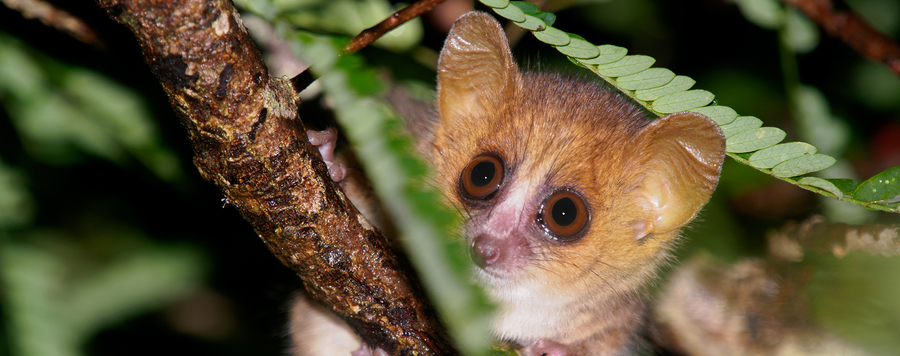
The IUCN Red List of Threatened Species 2020: Mme. Berthes mouse lemur (Microcebus berthae)
Taxonomic Notes
Microcebus berthae is the name given to the diminutive Rufous-colored Mouse Lemur from Kirindy/CFPF, originally called M. myoxinus by Schmid and Kappeler (1994).
Justification
A population reduction of ≥80% in this species is suspected to be met over ten years (generation length= 2.5 years, Radespiel et al. 2019) based on a decline in the area of occupancy (AOO), extent of occurrence (EOO) and/or habitat quality, where the projected time frame includes both the past and the future (2016-2026) as well as only the future. The causes of this reduction are ongoing extensive rates of forest/habitat loss due to slash and burn agriculture which results in continuing decline in the AOO, EOO and habitat quality. These causes have not ceased and may not be reversible. Furthermore, the local subpopulation of Kirindy Forest monitored on a regular basis over more than the last 10 years has been declined to zero individuals in 2019. Based on these premises, the species is listed as Critically Endangered (A3c+4c).
Geographic Range Information
The distribution of Microcebus berthae is restricted to the dry forest of Kirindy and Ambadira within the Menabe-Antimena Protected Area in the Menabe region, west Madagascar. It is best known from studies conducted at Kirindy Forest/CNFEREF. The Extent of Occurrence (EOO) is less than 810 km2. It is suspected that the EOO and habitat quality are decreasing.
Population Information
In 2005, the total population of this species was estimated at no more than 8,000 adult individuals living in a small number of remaining forest fragments, which are under high risk of destruction and fragmentation (Schwab and Ganzhorn 2004). Population densities across Menabe Central were estimated to be on average 80 individuals/km2 in 2006/07 (Schäffler and Kappeler 2014). However, the previous study also found strong variation in occurrence across different habitat types. Microcebus berthae was found significantly less often in degraded habitats compared to non-degraded habitats. Moreover, only 40-50 % of transects (depending on season) were occupied by the species across its range (Schäffler and Kappeler 2014). This suggests that the overall generalized density might be in the order of 30 ind./km2. Interspecific interactions with dwarf lemurs stabilizing coexistence with the competitively superior grey mouse lemur are limited to intact habitat and forest degradation therefore reduces M. berthae’s potential area of occurrence (Schäffler et al. 2015). As of 2019, the maximum occupied area has been calculated to be between 13,920 and 34,800 ha (Markolf et al. supporting material).
The remaining forest fragments of the Menabe region are under immense threat by slash and burn agriculture for maize and peanuts. Annual deforestation rates within the Extent of Occurrence exceeded 4,000 ha in 2017 and 2018. If deforestation continues at the same rate as during the last years the remaining habitat and the species might be lost within the next 10 years. High rates of degradation have already affected some subpopulations; one regularly-monitored subpopulation of the Kirindy Forest declined to zero individuals in 2019 after ten years of monitoring. As such, an ongoing population decline of at least 80% is suspected to be ongoing and to continue three generations into the future due to high rates of forest and habitat loss.
Habitat and Ecology Information
This species inhabits an area of dry deciduous forest; perhaps occasionally in secondary forest (from sea level to 150 m). This species feeds on fruits and gums, and relies heavily on sugary insect excretions and animal matter during the harsh dry season. It is a solitary forager characterized by extensively overlapping home ranges, the ranges of males (4.9 ha) being substantially larger than those of females (2.5 ha) and more prone to seasonal fluctuation (Schwab and Ganzhorn 2004). Microcebus berthae is the world's smallest primate.
Threats Information
The main threats to this species are habitat loss and degradation due to slash and burn agriculture (hatsake), harvesting of trees for charcoal production and illegal logging. These threats are currently not under control.
Conservation Actions Information
This species is listed on Appendix I of CITES. The recently established 125,000-ha Menabe-Antimena Protected Area encompasses the 30,000-ha strict conservation zone that includes the Kirindy Forest, and the currently unprotected Ambadira forests, all of which provide official protection for this species. However, conservation measures seem not to be effective or sufficient to halt ongoing deforestation. Laws are not enforced in a sufficient way. The species probably does not occur anymore in the Andranomena Special Reserve, an old reserve immediately adjacent to the new protected area (Schäffler and Kappeler 2014). It was formerly found in the Analabe Private Reserve as well, but has likely been extirpated from this area as the Analabe Private Reserve does not include any forest at present. As of 2019, this species was not being kept in captivity.






